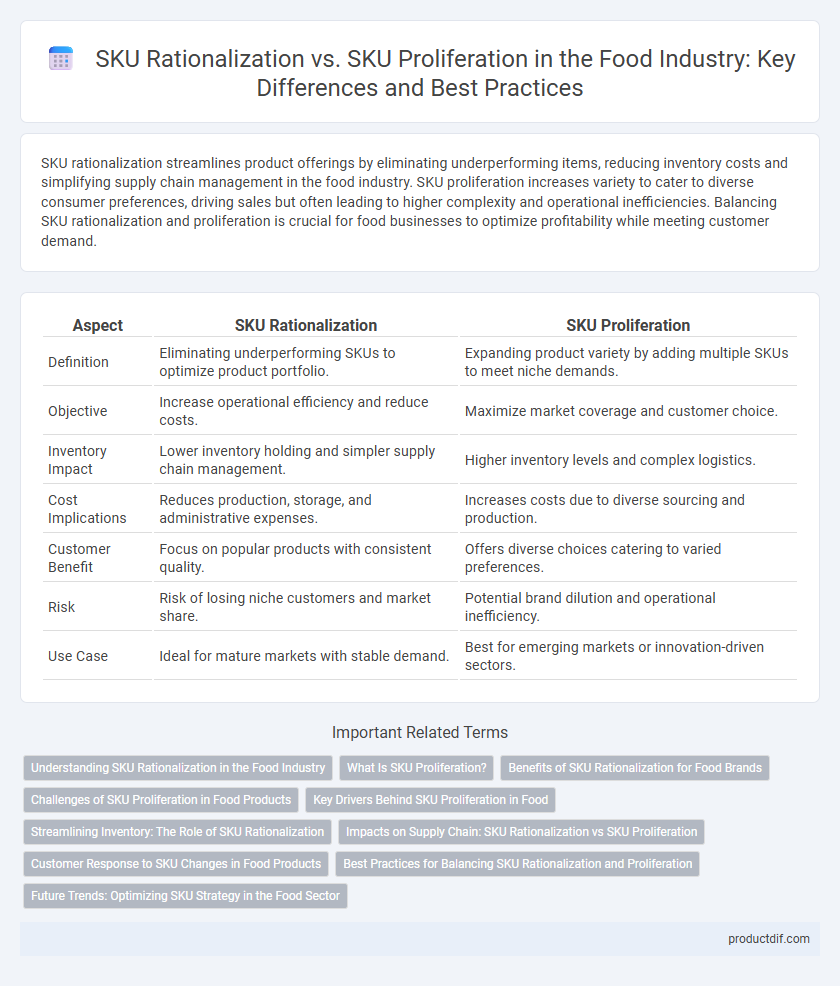SKU rationalization streamlines product offerings by eliminating underperforming items, reducing inventory costs and simplifying supply chain management in the food industry. SKU proliferation increases variety to cater to diverse consumer preferences, driving sales but often leading to higher complexity and operational inefficiencies. Balancing SKU rationalization and proliferation is crucial for food businesses to optimize profitability while meeting customer demand.
Table of Comparison
| Aspect | SKU Rationalization | SKU Proliferation |
|---|---|---|
| Definition | Eliminating underperforming SKUs to optimize product portfolio. | Expanding product variety by adding multiple SKUs to meet niche demands. |
| Objective | Increase operational efficiency and reduce costs. | Maximize market coverage and customer choice. |
| Inventory Impact | Lower inventory holding and simpler supply chain management. | Higher inventory levels and complex logistics. |
| Cost Implications | Reduces production, storage, and administrative expenses. | Increases costs due to diverse sourcing and production. |
| Customer Benefit | Focus on popular products with consistent quality. | Offers diverse choices catering to varied preferences. |
| Risk | Risk of losing niche customers and market share. | Potential brand dilution and operational inefficiency. |
| Use Case | Ideal for mature markets with stable demand. | Best for emerging markets or innovation-driven sectors. |
Understanding SKU Rationalization in the Food Industry
SKU rationalization in the food industry involves analyzing product portfolios to eliminate underperforming or redundant items, thereby reducing costs and improving supply chain efficiency. By focusing on high-demand SKUs, companies optimize inventory management and enhance profitability while meeting consumer preferences more effectively. This strategic approach balances variety with operational simplicity, supporting sustainable growth and competitive advantage.
What Is SKU Proliferation?
SKU proliferation refers to the rapid increase in the number of product variations offered by a food company, including different flavors, sizes, and packaging options. This expansion aims to cater to diverse consumer preferences and capture market segments but can lead to increased production complexity, higher inventory costs, and supply chain inefficiencies. Managing SKU proliferation effectively requires balancing variety with operational efficiency to optimize profitability and customer satisfaction.
Benefits of SKU Rationalization for Food Brands
SKU rationalization enables food brands to streamline their product portfolios, reducing inventory costs and minimizing waste. Concentrating on high-performing SKUs enhances supply chain efficiency and improves demand forecasting accuracy. This targeted approach boosts profitability by allowing brands to focus marketing efforts and shelf space on products with the greatest consumer appeal.
Challenges of SKU Proliferation in Food Products
SKU proliferation in food products creates significant supply chain complexities, increasing inventory holding costs and leading to potential waste due to perishable items. Managing extensive product variations strains production efficiency and complicates demand forecasting, causing stockouts or overproduction. Retail shelf space becomes fragmented, reducing product visibility and impacting overall category profitability.
Key Drivers Behind SKU Proliferation in Food
SKU proliferation in the food industry is primarily driven by evolving consumer preferences for diverse flavors, dietary requirements, and convenience-focused packaging formats. Retailers and manufacturers also push for greater assortment variety to capture niche markets and respond to competitive pressures in crowded supermarket aisles. Innovation cycles and marketing strategies targeting personalization and premiumization further contribute to the rapid increase in the number of SKUs offered.
Streamlining Inventory: The Role of SKU Rationalization
SKU rationalization plays a crucial role in streamlining inventory by reducing excess stock and minimizing carrying costs, enabling food businesses to focus on high-performing products. This strategic process enhances supply chain efficiency, improves inventory turnover, and reduces waste caused by perishable food items. Effective SKU rationalization supports better demand forecasting and optimizes shelf space utilization, ultimately contributing to increased profitability in the food industry.
Impacts on Supply Chain: SKU Rationalization vs SKU Proliferation
SKU rationalization enhances supply chain efficiency by reducing complexity, lowering inventory carrying costs, and improving demand forecasting accuracy. In contrast, SKU proliferation increases supply chain strain, causing higher warehousing expenses, longer lead times, and greater risk of stockouts or overstocks. Optimizing SKU count balances product variety with operational agility, maximizing supply chain responsiveness and cost-effectiveness.
Customer Response to SKU Changes in Food Products
Customer response to SKU rationalization in food products often reflects increased satisfaction due to simplified choices and improved product availability. In contrast, SKU proliferation can lead to decision fatigue and reduced brand loyalty as consumers face overwhelming options. Effective SKU management balances variety with clarity, optimizing consumer engagement and purchase behavior.
Best Practices for Balancing SKU Rationalization and Proliferation
Effective SKU rationalization in the food industry involves analyzing product performance data, consumer demand trends, and supply chain costs to identify underperforming or redundant items. Balancing SKU proliferation requires maintaining a diverse product range that meets varied customer preferences while minimizing complexity through strategic category management and regular portfolio reviews. Leveraging advanced analytics and cross-functional collaboration ensures optimal inventory levels and enhances profitability without sacrificing market responsiveness.
Future Trends: Optimizing SKU Strategy in the Food Sector
Future trends in the food sector emphasize optimizing SKU strategy by balancing SKU rationalization and proliferation to reduce operational costs while meeting diverse consumer demands. Advanced data analytics and AI-driven insights enable precise identification of high-performing SKUs, eliminating underperforming products without sacrificing variety. Sustainability considerations and consumer personalization further drive strategic SKU optimization, enhancing supply chain efficiency and market responsiveness.
SKU Rationalization vs SKU Proliferation Infographic

 productdif.com
productdif.com